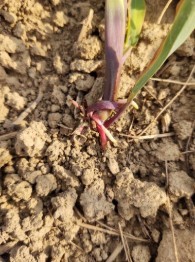By Alexander Lindsey and Peter Thomison
In recent days we have been experiencing 90 degree F days with limited precipitation, and so we are starting to see some leaf rolling in corn. Some of this may be related to reductions in soil moisture, but may be related to restricted root systems as well. Depending on the stage of corn at the time of these conditions, different effects on yield may be expected. Corn ear development occurs throughout the growing season, and extreme temperature or moisture stress at different growth stages will decrease different aspects of grain yield. Below is a quick summary of the yield component most affected by environmental stress at different growth stages:
- V5-7: Number of kernel rows. Corn plants are determining the number of kernel rows as early as V5 in some corn hybrids. By V7, the number of kernel rows in the primary ear has been determined for most hybrids.
- V9-VT: Number of potential kernels per row (row length). Each potential kernel comes from one floret on the ear (female flower), and as conditions are more favorable for development the plant will initiate more florets. The number of potential kernels on the ear can be set through late vegetative stages (through V16).
- VT/R1: Number of potential kernels that are fertilized. High temperatures and moisture stress can cause pollen release to occur before silk emergence resulting in poor pollination, and can decrease pollen grain viability. Ear elongation is occurring during R1, and if stress occurs total ear length could be decreased. Yield losses have been estimated up to 13% per day of stress.
- R2-R3: Kernel number to be filled. Stress at the blister (R2) and milk (R3) stage can cause fertilized kernels to be aborted due to poor carbohydrate availability. Carbohydrate production will decrease as temperature and moisture stress increase because photosynthesis is reduced. The limited production of sugars will cause the plant to abort kernels, typically those that were the last to be pollinated (at the tip).
- R4-R5: Kernel size. At the dough (R4) and dent (R5) stages, carbohydrate accumulation within the kernels will be reduced due to environmental stress. At the start of R5, only 45% of the dry matter in each kernel has been accumulated, leaving half of the starch to be added during R5. However, the kernel contains 90% of its dry matter halfway through the R5 growth stage (milkline halfway down the kernel).
Given corn growth is maximized at 86 degrees F, temperatures exceeding this can result in reduced growth rates. Leaf area may decrease under stress conditions leading to less area available to photosynthesize, and internodes may not lengthen as much leading to shorter plants. Moisture stress can also be observed as leaf rolling. Rolled leaves help to shade the leaves by reducing the area in direct interception of light and to thicken the boundary layer (leading to less evaporation and slower water movement out of the leaves). However, leaf rolling can be seen even if soil moisture is evident under high temperatures and lower relative humidity levels. Be sure to watch the video on this topic here.

Higher temperatures (especially at night) can lead to more respiration, which could reduce yield by metabolizing sugars (rather than moving them to the kernels). Hot days also mean faster GDD accumulation during the season and can shorten the number of days the crop has to photosynthesize and create sugars. For example, let’s say a hybrid needed 1350 GDDs to reach maturity after flowering. With a daytime temperature of 86 F and night temperature of 68 degrees F, it would take 50 calendar days to accumulate 1350 GDDs. Conversely, with a day temperature of 86 F and a night temperature of 63 F, it would take 56 calendar days to reach that same GDD accumulation.
In parts of the state there may be soil moisture present but root systems are being affected by soil compaction restricting growth. Another issue that has been observed is rootless or floppy corn. Seed planted in loose dry soil that becomes compacted after planting may be prone to this as well. If leaf rolling is showing up in your fields, consider digging some plants to assess the root systems and levels of soil moisture within the field.
Figure 1 – Corn showing leaf rolling symptomology.
Figure 2 – Rootless corn showing nodal roots developing outside soil environment.
Source : osu.edu